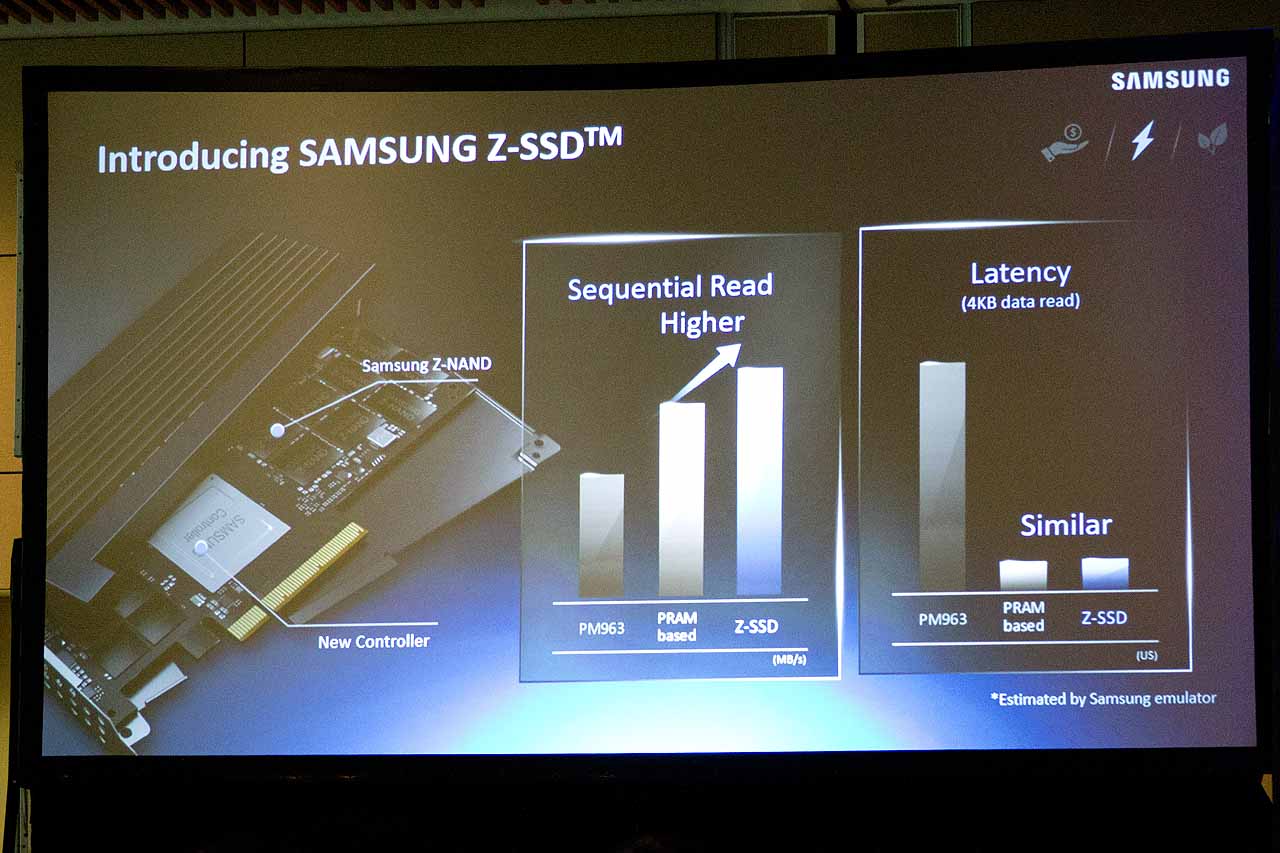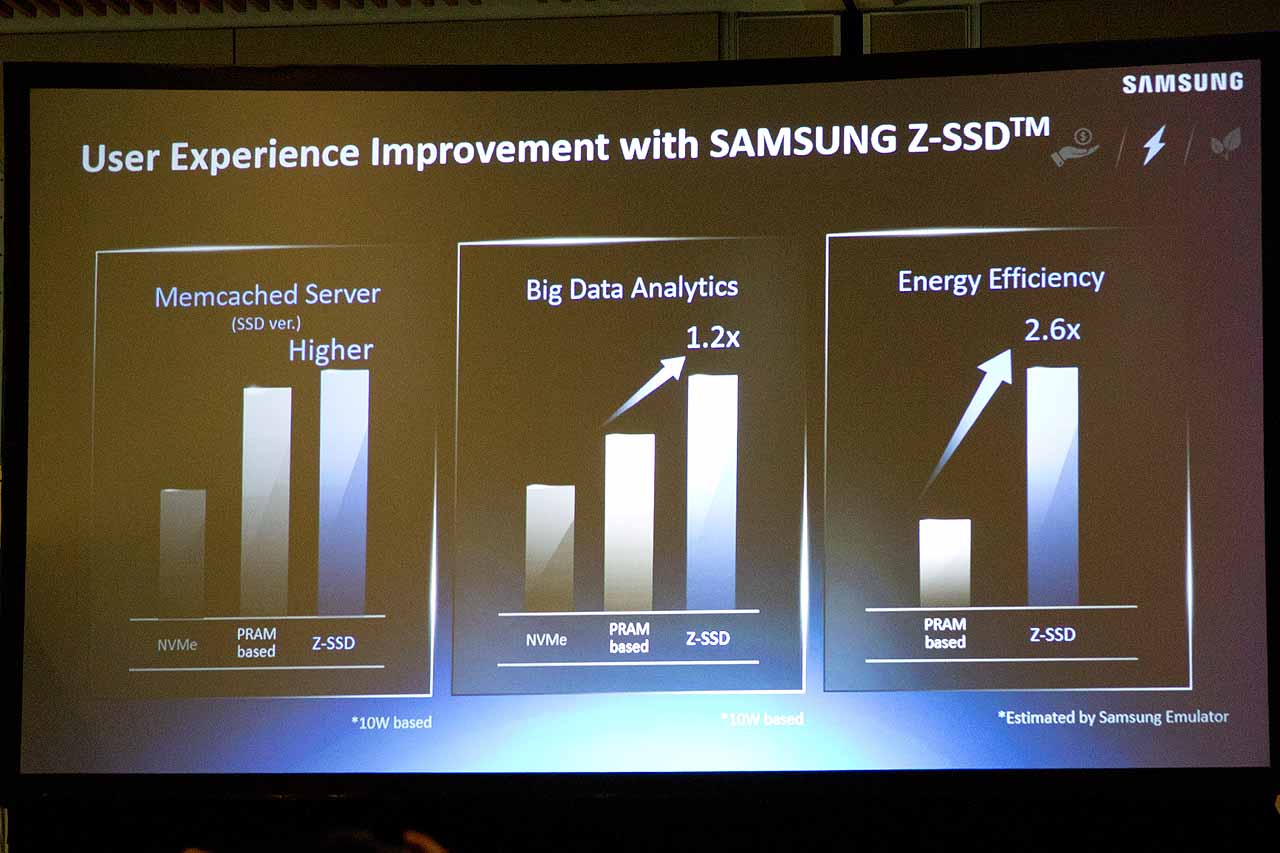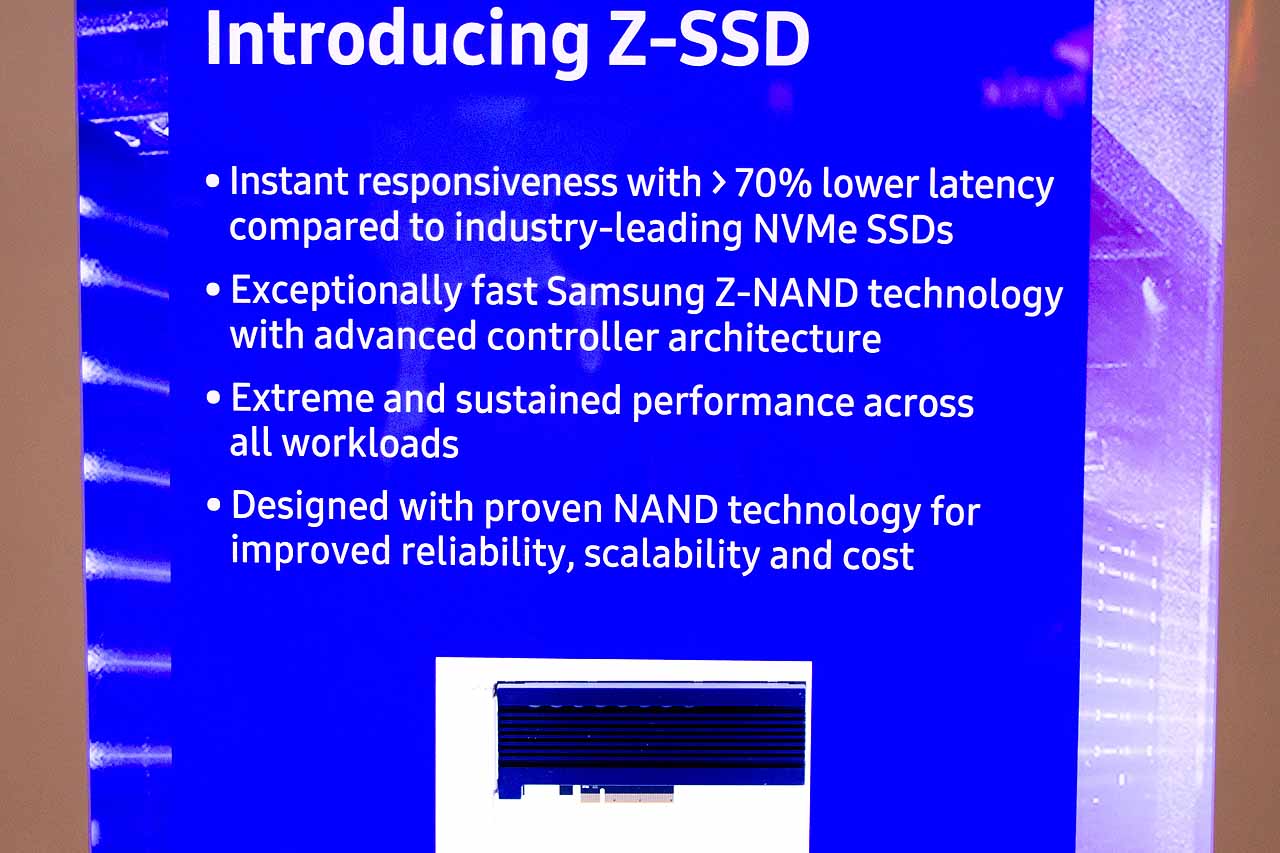Samsung Begins 3D XPoint Assault With Z-NAND SSDs And HybriDIMMs
Samsung debuted its new Z-NAND at the Flash Memory Summit this week in an obvious ploy to undercut IMTF 3D XPoint before it comes to market, but the company also has another initiative to attack in the memory space.
On the surface the new 1 TB Z-SSD, which is built with Samsung's new Z-NAND, is very similar to other existing PCIe SSDs. Samsung claims that this new specialized version of NAND provides a radical performance increase compared to existing NAND-based SSDs.
Samsung Attacks 3D XPoint Storage Applications
Samsung presented slides that listed the Z-SSD's performance specifications, but a note in the bottom right-hand corner of the slides indicates that it derived the benchmarks from an emulator. This may indicate that the company doesn't actually have physical products yet and is relying on simulations to derive performance specifications. The company compared the SSD to both NAND-based and PRAM-based SSDs. Phase-Change RAM (PRAM) is a glass-type of non-volatile chalcogenide memory that many speculate Intel/Micron uses with 3D XPoint. It appears that Samsung is implying that it can offer similar performance and latency to 3D XPoint.
In either case, the slides indicate much higher throughput than a normal SSD (1.6x better than a Samsung PM963 NVMe SSD) and radically reduced latency that is on par with the PRAM-based SSD. The fact that Samsung has a PRAM-based SSD for comparison, however, is telling. The company, like many other fabs, constantly has new technologies under development, and it's possible that we may see a PRAM-based SSD in the future.
Samsung representatives informed us that the new NAND would have SLC-like endurance specifications, which implies that the new Z-NAND is simply using the entire capacity of an MLC NAND product programmed as SLC. The company also notified us that it based the new technology upon its existing 3D NAND technology, so it is likely using a 64-layer architecture. One of the key differentiators, beyond performance, is that the Z-SSD promises incredible scaling and maximum IOPS under low QD workloads. This is similar to the 3D XPoint performance profile, and like its competitor, this is likely due to an increased number of planes.
Normal NAND-based SSDs require an excessively heavy workload--rare in normal use--to extract the maximum performance. This is because the NAND die need to respond en masse to incoming requests. NAND vendors boost the performance of individual die by splitting the die into separate regions that can respond to commands separately (increase parallelism). The majority of current generation NAND are dual-plane designs, but Micron 3D NAND employs a quad-plane design to increase performance.
3D XPoint doesn't have the traditional plane architecture, but the company disclosed that there are 64 regions that can respond independently, which is similar to a 64-plane architecture. Samsung may have boosted the number of planes per Z-NAND die to achieve a similar level of performance and parallelism. Coupling the extra die with SLC, which is much faster and endurant than MLC and TLC NAND, would provide tremendous performance benefits.
Get Tom's Hardware's best news and in-depth reviews, straight to your inbox.
Samsung provided results, again generated with an emulator, that show higher performance (up to 1.2X in a big data analytics workload) and much lower power consumption than the PRAM-based SSD. The NAND-based SSD trails far behind the PRAM and Z-NAND solutions, but Samsung did not provide a direct power comparison between NAND and Z-NAND. The company also did not provide any random performance specifications during the announcement, but did note that the new SSD will use the NVMe protocol and will be faster than existing NVMe SSDs. Most NVMe SSDs top out in the range of 750,000 IOPS with a x4 connection and 1 million IOPS with a x8 connection. Samsung also divulged to us that the Z-SSD would offer up to a 7x improvement in 99.99th percentile latency (worst-case) over existing NAND-based SSDs.
Samsung representatives noted that because it based Z-NAND on existing NAND technology it will be much cheaper to produce, while its 3D XPoint competitors are investing billions in new fabs and tooling. The impact of the increased investments have already shown up in Intel's financial reports, and the extra cost will push the price of 3D XPoint up beyond NAND-based SSDs.
Samsung Attacks 3D XPoint as Memory
Samsung is also squeezing 3D XPoint, which can be used as either storage or memory, on the RAM axis. Samsung's partner Netlist also announced its new HybriDIMM products, which use HyperVault technology.
Samsung invested a total of $23 million in Netlist last year to develop the HyperVault technology. The result of the investment is the new HybriDIMM products, which connect into a DDR4 LRDIMM slot and allow the system to address large repositories of NAND (up to 512 GB with the first-gen product and 1 TB with the second-gen product) as either storage or memory.
The DIMMs work without a BIOS change, which will be unlikely with 3D XPoint DIMMs, and use PreSight predictive algorithms to pre-fetch and stage data from NAND into a small amount of DRAM (8-16 GB) on board the DIMM, thus alleviating performance limitations.
These new DIMMs will allow users to place terabytes of RAM into a single server in a much more cost-effective manner than current DRAM and 3D XPoint. We have deeper coverage of the technology here. HybriDIMMs use Samsung NAND, but it would be logical to assume that we might also see Z-NAND on them in the future.
Shots Fired
Samsung's line of attack with the Z-SSD might help price 3D XPoint out of the market for storage applications. Combining the storage assault with lower-cost HybriDIMM memory alternatives will also provide additional pressure. The kicker is that Samsung based all of the new products on proven and mature technologies, which is important for the lucrative data center market that Intel and Micron are chasing.
Samsung's strategy capitalizes on the simple fact that in most cases good-enough and cheap will win, but we will have to wait until products hit the market to see if it pans out.

Paul Alcorn is the Editor-in-Chief for Tom's Hardware US. He also writes news and reviews on CPUs, storage, and enterprise hardware.
-
memadmax I like samsungs' approach with the HybriDIMM alot better than intel's, because intel is in cahoots with microsoft to lock down the system via tech corraling: "You want to run this hardware? Well then you have to run this microsoft operating system"...Reply
Get it? And you guys that are cheerleading microsoft and winblows 10 are might as well be the sheep in that corral... -
hannibal The support for X-point will arrive to Linux and iOS platforms too, so no worry in there. But hybriDimm works now, so it has merits on its own.Reply -
epobirs Considering who the biggest customers for 3D Xpoint as memory are likely to be and that those same customer aren't likely to be building their systems for Windows Server, I very much doubt this is going to be locked into Wintel offerings. The use case for really big enterprise systems is far easier to find than that for a desktop PC. I would expect a lot of work remains to be done before a desktop OS really knows how to much real use of this. It can be treated as a traditional RAM disk but that is just scratching the surface of the potential.Reply -
jasonf2 In the immediate term Hybridimm will only have server applications. Most (if not all) consumer motherboards and chipsets will top out on addressable memory long before 256 gb. Intels magic here will be that the 200 series chipset coming with kabilake will support xpoint and handle the increased headroom necessary to put nonvoltile on the memory bus. Samsung's move here could lead to some workstation class boards becoming popular in the high end consumer class depending on how expensive xpoint really is (in the short term). At the very least we should see some competition here starting the race to the bottom on the emerging techs. I hope AMD and Zens chip set are taking all of this into account and at least getting ready for the need for a terabyte+ of memory on the Ram bus.Reply -
serendipiti I don't agree the assumption of endurance coming from using TLC NAND as SLC.Reply
I suppose the difference between 3D NAND and Z-NAND is that 3D NAND is stacking 2D NAND in multiple layers, while Z NAND takes the 3D concept to the cell itself by changing the doping areas and materials. This way the cell may have less leaks, resulting in a higher endurance, etc... -
josejones So, when will these new Samsung Z-SSD's come available and for which chipset? The Z-270 or the Z-370 motherboards? Kaby Lake or Cannon Lake? 2017 or 2018?Reply -
hannibal Well, the point of hybriDimm is that it use old production techniques, so it can be produced with old factories. That seems to prove the point that this is indeed MLC acting in SLC mode. That makes it relatively cheap to produce them, compared X-point that requires own production capasity and technic.Reply -
Tykkopoles Reply18424801 said:I like samsungs' approach with the HybriDIMM alot better than intel's, because intel is in cahoots with microsoft to lock down the system via tech corralling...
So you approve a technology of one company not because the technology has any merit, but simply because you are throwing a temper-tantrum about that company's competitor. GGWP, mate.
In adult news, Z-NAND and HybriDIMM are both very cost-effective approach for enterprises to massively overhaul storage and memory solutions. I'm definitely interested to see some non-emulated tests on performance under heavy server workloads. I, for one, am happy that there are multiple companies innovating on volatile and non-volatile options. -
computerguy72 Funny how Samsung had to 'massage' the numbers using the xpoint results adapted to a pcie x4 with standard drivers and then using a emulated 'simulation' to get their own numbers in there. Intel/Micron seem to have a solution that can dramatically outperform anything else. Samsung no doubt hopes to dull the enthusiasm but they will need to do better than this that's for sure.Reply




